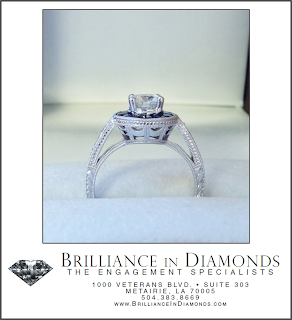The Alphabet Soup of Diamond Certificates
Certifications and Their Meaning
GIA, IGI, EGL USA, EGL International, AGS…the list goes on. There are quite a few diamond grading labs out there that claim to offer you specific details on a particular diamond. These labs will present you with a shiny laminated certificate and give you valuable information known in the jewelry business as the “4 C’s.” These 4 C’s are a diamond’s cut, color, clarity, and carat weight. While all of these certificates appear and look legitimate the truth is there is only one diamond grading laboratory and certificate that matters in the business. The Gemological Institute of America, more commonly known as GIA, is the industry standard for grading diamonds.Imagine this scenario; you walk into a jewelry store and you see a sign declaring, “EGL International Certified 1.00ct G Color, VS1 Clarity Diamond on sale for $3000!” That’s an incredible deal you are thinking to yourself, but you want to shop one more place before you make your final decision. At the next store you see a similar sign that reads, “GIA Certified 1.00ct G Color, VS1 Clarity Diamond on sale for $5,500!” You then think to yourself that the first store you went to has the much better deal and that the second store is trying to rip off their customers. You make your way over to the first store and buy that diamond laughing all the way home about the great deal you got. Here is the bad news…you have just fallen victim to an unfortunate, but prevalent ploy in the jewelry business. The second store with the GIA Certified diamond had the much better deal! Here is how it works:
A jewelry store banks (literally!) on this scenario above. Most people do not know that there is a vast difference in the standards each lab applies to grading diamonds. That EGL International Certified diamond you thought was a G Color, VS1 Clarity could actually be a J or K Color and an SI2 or even I1 Clarity! It’s an unfortunate part of the jewelry business because it misleads consumers in to thinking they are getting something they actually aren’t. These “other labs” are for-profit and therefore will grade extremely loose in order to get and continually receive a jewelry store’s business. Some laboratories are better than others, but they will all most likely be at the minimum 1 or 2 color and clarity grades off. What I find even more troubling is when a store (there are a few like this) has their own grading laboratory and certificate. This presents a very big conflict of interest because of course they are going to grade their diamonds favorable.
You are probably wondering why GIA is the best. GIA literally wrote the book when it comes to grading diamonds. They actually invented the color and clarity charts that all laboratories use today. They grade the diamond for what it is and not what someone wants it to be. Whether it is Elizabeth Taylor’s priceless collection of diamonds or The Hope Diamond they only go to one place; and that is GIA. Does that mean you can’t get a nice diamond engagement ring if it isn’t certified by GIA? Not at all. In fact, I always tell people that every diamond is uncertified before it goes to GIA and gets a certificate. What it means is that you need to make sure everyone is playing by the same rules when it comes to presenting the 4 C’s of their diamonds. When shopping if you come across a diamond that is uncertified or has a certificate not from GIA ask the person if they can guarantee the color and clarity they are presenting is correct by GIA’s standards. Tell them that after purchasing you are going to send the diamond to GIA and you want in writing from them that if the diamond is more than one color or clarity grade off you can get a refund. We give them room for error of one color and clarity grade because there is some subjectivity, especially with clarity, and it is tough to know exactly what GIA will say sometimes. However, 99% of jewelers can get within one color and clarity grade very easily. If they can’t or won’t guarantee this then you know the answer to your question already. They aren’t presenting their diamonds correctly in terms of color and clarity. Any jeweler who doesn’t attempt to grade their diamonds by GIA’s standards is simply misleading the consumer.
